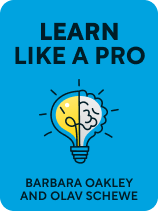

This article is an excerpt from the Shortform book guide to "Learn Like a Pro" by Barbara Oakley and Olav Schewe. Shortform has the world's best summaries and analyses of books you should be reading.
Like this article? Sign up for a free trial here.
What’s the best way to use the Pomodoro method when learning something new? Is it possible to deliberately switch between two different modes of attention?
In Learn Like a Pro, Barbara Oakley and Olav Schewe explain that the brain has two modes of attention: focused and diffuse mode. They discuss how each mode works and then show how you can use both focused and diffuse modes of attention in learning.
Read more to understand how these modes of attention work, and how you can effectively put them to work for you.
How Different Modes of Attention Can Help You Learn
The authors explain how focused and diffuse modes of attention in learning are used in alternation with each other. They show that, by properly engaging both modes, you can better learn new concepts and skills, understand complex topics, and move past periods when you feel stuck and can’t seem to make progress in your learning.
Focused mode is when you deliberately concentrate on a task in front of you—for example, reading a chapter from your textbook or memorizing new information. This mode is best for strengthening your understanding of familiar topics or gaining new knowledge related to things you already know, such as learning new vocabulary in your native language. This is because focused mode uses neural connections that have already been formed in your brain.
Diffuse mode is when you’re not focusing on any one thing in particular but instead are letting thoughts flow through your mind naturally—as happens when you’re going through routine parts of your day like making breakfast or driving to work. As you’re doing these things, your brain works on problems and processes new information “in the background” by making novel connections (building new neural pathways) between ideas and knowledge that it cannot make while in focused mode. These new neural pathways are what integrate new learning into your brain.
| A Deeper Look at the Brain’s Modes of Attention In Focus, Daniel Goleman refers to focused mode as selective attention and diffuse mode as mind-wandering. Goleman’s selective attention (focused mode) is effortful attention that helps your brain filter information from your senses and focus on what is relevant. With strong selective attention skills, you can focus on a task and ignore distractions, deal with emotional distractions during stressful times, and direct your attention away from worrisome thoughts. These abilities are crucial for engaging meaningfully with learning tasks by giving you control over where you put your mind to use. Goleman’s mind-wandering (diffuse mode) is the brain’s “default mode,” meaning it happens automatically when you’re not deliberately focusing on something, causing your mind to wander from topic to topic. He writes that mind-wandering can spark enormous creativity because your brain makes unique connections unconsciously before they emerge into your awareness. |
To learn something complex, you’ll need to alternate between focused and diffuse modes. When you’re learning something simple, focused mode will be all you need. But, when you’re learning something complex, you won’t be able to fully absorb the concepts if you stay in focused mode alone. This is because, in focused mode, your brain suppresses all thoughts except what you’re purposefully paying attention to, which will prevent you from making the “aha” connections between different pieces of information that diffuse mode encourages.
Switch back and forth between both modes to build and strengthen your understanding of new ideas: Work in focused mode until you start to get stuck, then switch to diffuse mode to let your brain work on those ideas in the background. Then switch back to focused mode to continue your learning again.
(Shortform note: In Learning How to Learn, Oakley has a slightly different way of explaining how alternating between focused attention and diffuse mode optimizes learning. She says focused mode allows you to comprehend the problem at hand, taking a mental break in diffuse mode allows your brain to discover the solution, and switching back into focused mode again allows you to apply the solution to the problem.)
How to Improve Your Focused Mode
The authors say you can improve the power of your focused mode with the following tips:
Reduce distractions. The authors advise making your environment as distraction-free as possible and minimizing interruptions. Choose a location where socializing doesn’t typically occur, such as a quiet library or private study space. If you can’t avoid noise, consider using noise-canceling headphones or earplugs. Keep your phone out of sight, disable notifications on your electronic devices, or use website blockers to avoid being distracted by social media or other notifications.
(Shortform note: What makes something a distraction? In Hyperfocus, Chris Bailey defines distraction as anything that hinders you from accomplishing your intended goal or task. In other words, if something takes your attention away from what you intend to or need to concentrate on, it can be considered a distraction. This implies that anything has the potential to become a distraction if it interferes with your focus.)
Avoid multitasking. The authors advise that you only multitask (switch back and forth between tasks) infrequently. Studies show that constantly switching between tasks harms your ability to concentrate, which makes you more likely to make mistakes and hurts your ability to write and remember information. This is because part of your attention lingers on your previous task—what the authors call attention residue—which prevents you from fully focusing on the new one.
However, task-switching has some benefits: It can foster creative thinking by freeing you from ruts in your thinking that can occur when you concentrate for too long on a single task by changing and expanding your perspective.
Have a plan for interruptions. The authors recommend that when inevitable interruptions occur, like your child coming into your office to ask a question, take a moment to note where you will leave off in whatever you are focusing on—the paragraph number on the page of a book, for example. This gives your brain a sense of closure that reduces the attention residue of multitasking, therefore helping you regain focus when you return to your learning task. Acknowledge and respond to the interruption, and then make a clean break from the interruption and completely switch your attention back to your learning.
(Shortform note: In Eat That Frog!, Brian Tracy explains that when you switch back and forth between tasks or deal with a lot of interruptions while you’re trying to work (or learn), it takes an average of 17 minutes for you to fully regain your focus. In other words, attentional residue can last a long time. Tracy says the more you task-switch and deal with interruptions, the more mistakes you make, increasing the time you need to complete something by over 500%. In contrast, when you commit to focusing on one thing at a time and minimize interruptions, you can complete a task in less than half the time it would take you otherwise.)
How to Use Diffuse Mode for Learning
Being in diffuse mode might feel unproductive for learning compared to focused mode because it seems like you’re not doing anything. But the authors assert that diffuse mode is essential for learning complex topics or skills and can help you get unstuck when you’re struggling to learn something new.
[Shortform note: In addition to helping you learn, Daniel Goleman highlights some other benefits of mind-wandering (diffuse mode), including facilitating self-reflection and problem-solving by allowing your attention to sort through personal concerns, dilemmas, and regrets. However, he warns that letting your mind wander too much can lead to rumination, negatively affecting your quality of life and disrupting your concentration (focused mode).]To take advantage of diffuse mode, the authors advise you to take frequent, five- to 10-minute breaks while learning. The specific technique they recommend to incorporate breaks into your process is the Pomodoro method:
- Remove distractions from your environment, especially easily accessible technology distractions like open computer tabs and cell phones.
- Set a timer for 25 minutes.
- Concentrate as much as you can on your learning task.
- After 25 minutes, take a break for five minutes. The break should be an activity that doesn’t require much concentration, like stretching for a few minutes or petting a pet. Checking emails and social media doesn’t count as a break, as these activities do not put your mind in diffuse mode.
- Repeat the timed work and break cycles as necessary.
(Shortform note: The Pomodoro method is a popular tool among education and psychology experts, and one expert offers a twist on the method: Instead of using a timer to divide your learning time into 25-minute chunks with a break in between, use a music streaming service, like Pandora, which plays music for about 20-30 minutes interspersed with short commercial breaks. Work while the music is playing and take your breaks during the commercials—this way, you won’t have to set and reset a timer, and you can enjoy music as you study as long as it’s not distracting.)

———End of Preview———
Like what you just read? Read the rest of the world's best book summary and analysis of Barbara Oakley and Olav Schewe's "Learn Like a Pro" at Shortform.
Here's what you'll find in our full Learn Like a Pro summary:
- Proven techniques for mastering new skills and knowledge quickly
- How to improve your memory, increase your focus, and manage your time
- Practical tips for how to excel in academic settings






